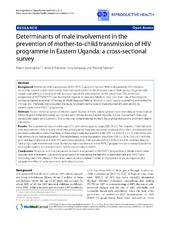| dc.contributor.author | Byamugisha, Robert | en_US |
| dc.contributor.author | Tumwine, James K. | en_US |
| dc.contributor.author | Semiyaga, Nulu | en_US |
| dc.contributor.author | Tylleskär, Thorkild | en_US |
| dc.date.accessioned | 2011-04-19T09:22:52Z | |
| dc.date.available | 2011-04-19T09:22:52Z | |
| dc.date.issued | 2010-06-23 | eng |
| dc.Published | Reproductive Health 7:12 | en_US |
| dc.identifier.issn | 1742-4755 | |
| dc.identifier.uri | https://hdl.handle.net/1956/4680 | |
| dc.description.abstract | Background: Mother-to-child transmission of HIV (MTCT) accounts for over 95% of all paediatric HIV infections worldwide. Several studies have shown that male participation in the antenatal care of their spouses together with couple counselling and testing for HIV, increases use of the interventions for HIV prevention. The prevention programme of MTCT (PMTCT) was launched in Uganda in 2000 and Mbale in 2002. Less than 10% of the pregnant women accepted antenatal HIV testing at Mbale Regional Referral Hospital in 2003; couple counselling and testing for HIV was low. Therefore, we conducted the study to determine the level of male involvement and identify its determinants in the PMTCT programme. Methods: A cross-sectional survey of 388 men aged 18 years or more, whose spouses were attending antenatal care at Mbale Regional Referral Hospital, was conducted in Mbale district, Eastern Uganda. A male involvement index was constructed based on 6 questions. The survey was complemented by eight focus group discussions and five in-depth interviews. Results: The respondents had a median age of 32 years (inter-quartile range, IQR: 28-37). The majority (74%) had a low male involvement index and only 5% of men accompanied their spouses to the antenatal clinic. Men who had attained secondary education were more likely to have a high male involvement index (OR: 1.9, 95% CI: 1.1-3.3) than those who had primary or no formal education. The respondents, whose occupation was driver (OR: 0.3, 95% CI: 0.1-0.7) or those who had fear of disclosure of their HIV sero-status results to their spouses (OR: 0.4, 95% CI: 0.2-0.8), were less likely to have a high male involvement index. Barriers to male involvement in the PMTCT programme were related to both the poor health system, to socio-economic factors and to cultural beliefs. Conclusions: Structural and cultural barriers to men's involvement in the PMTCT programme in Mbale district were complex and interrelated. Community sensitization of men about the benefits of antenatal care and PMTCT and improving client-friendliness in the clinics needs to be prioritised in order to improve low male participation and mitigate the effect of socio-economic and cultural factors. | en_US |
| dc.language.iso | eng | eng |
| dc.publisher | BioMed Central | eng |
| dc.relation.ispartof | <a href="http://hdl.handle.net/1956/7333" target="blank">The prevention of mother-to-child transmission of HIV programme in Eastern Uganda. Men’s involvement in a changing HIV testing policy context</a> | eng |
| dc.rights | Attribution CC BY | eng |
| dc.rights.uri | http://creativecommons.org/licenses/by/2.0 | eng |
| dc.title | Determinants of male involvement in the prevention of mother-to-child transmission of HIV programme in Eastern Uganda: a cross-sectional survey | en_US |
| dc.type | Peer reviewed | |
| dc.type | Journal article | |
| dc.description.version | publishedVersion | en_US |
| dc.rights.holder | Byamugisha et al. | |
| dc.rights.holder | Copyright 2010 Byamugisha et al; licensee BioMed Central Ltd. | |
| dc.identifier.doi | https://doi.org/10.1186/1742-4755-7-12 | |
| dc.identifier.cristin | 349233 | |
| dc.subject.nsi | VDP::Medical disciplines: 700 | eng |

